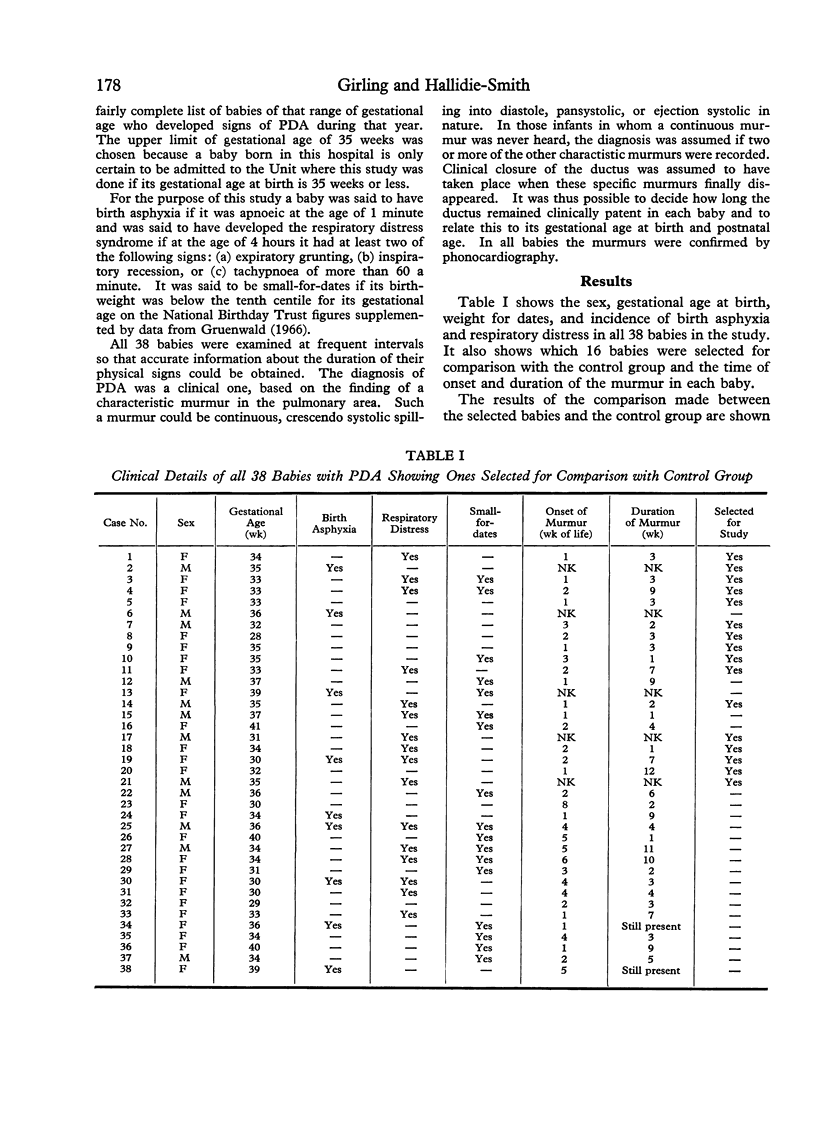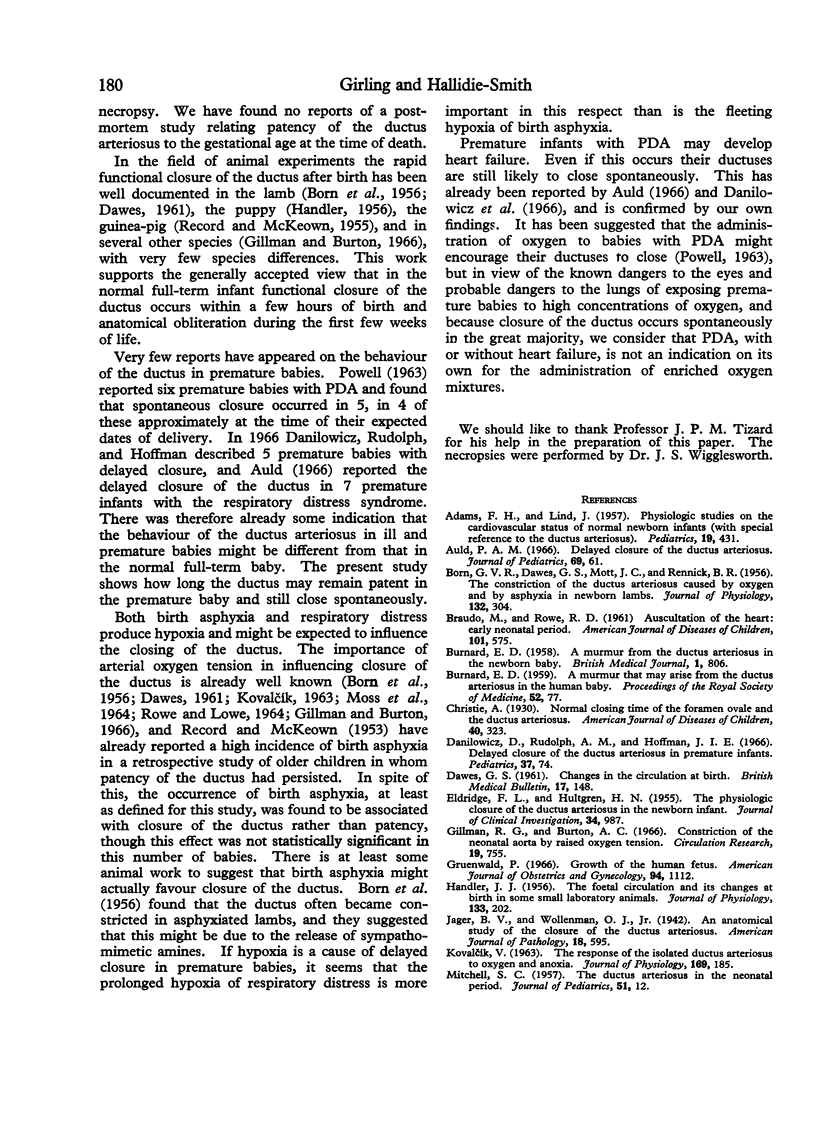Abstract
Thirty-eight ill and premature babies with a diagnosis of persistent ductus arteriosus (PDA) are described. All were patients in the Neonatal Unit of Hammersmith Hospital. 16 of them, who were born during a year in which all babies in the Unit were examined repeatedly and specifically for clinical evidence of PDA, have been compared to a control group in respect of sex, gestational age, weight for dates, birth asphyxia, and respiratory distress.
It is concluded that PDA in this selected group of babies was significantly associated with female sex and respiratory distress but not with gestational age, weight for dates, or birth asphyxia.
Though in these babies clinical evidence of PDA often persisted for several weeks, closure was spontaneous in the great majority.
Five babies developed heart failure and 4 of these responded well to medical treatment. It is suggested that in view of the frequency of spontaneous closure there is no indication to administer oxygen-enriched air to premature babies solely for the purpose of encouraging their ductuses to close.
Full text
PDF




Selected References
These references are in PubMed. This may not be the complete list of references from this article.
- ADAMS F. H., LIND J. Physiologic studies on the cardiovascular status of normal newborn infants (with special reference to the ductus arteriosus). Pediatrics. 1957 Mar;19(3):431–437. [PubMed] [Google Scholar]
- Auld P. A. Delayed closure of the ductus arteriosus. J Pediatr. 1966 Jul;69(1):61–66. doi: 10.1016/s0022-3476(66)80362-1. [DOI] [PubMed] [Google Scholar]
- BORN G. V., DAWES G. S., MOTT J. C., RENNICK B. R. The constriction of the ductus arteriosus caused by oxygen and by asphyxia in newborn lambs. J Physiol. 1956 May 28;132(2):304–342. doi: 10.1113/jphysiol.1956.sp005526. [DOI] [PMC free article] [PubMed] [Google Scholar]
- BURNARD E. D. A murmur from the ductus arteriosus in the newborn baby. Br Med J. 1958 Apr 5;1(5074):806–810. doi: 10.1136/bmj.1.5074.806. [DOI] [PMC free article] [PubMed] [Google Scholar]
- BURNARD E. D. A murmur that may arise from the ductus arteriosus in the human baby. Proc R Soc Med. 1959 Jan;52(1):77–78. [PMC free article] [PubMed] [Google Scholar]
- DAWES G. S. Changes in the circulation at birth. Br Med Bull. 1961 May;17:148–153. doi: 10.1093/oxfordjournals.bmb.a069890. [DOI] [PubMed] [Google Scholar]
- Danilowicz D., Rudolph A. M., Hoffman J. I. Delayed closure of the ductus arteriosus in premature infants. Pediatrics. 1966 Jan;37(1):74–78. [PubMed] [Google Scholar]
- ELDRIDGE F. L., HULTGREN H. N. The physiologic closure of the ductus arteriosus in the newborn infant. J Clin Invest. 1955 Jul;34(7 Pt 1):987–996. doi: 10.1172/JCI103167. [DOI] [PMC free article] [PubMed] [Google Scholar]
- Gillman R. G., Burton A. C. Constriction of the neonatal aorta by raised oxygen tension. Circ Res. 1966 Oct;19(4):755–765. doi: 10.1161/01.res.19.4.755. [DOI] [PubMed] [Google Scholar]
- Gruenwald P. Growth of the human fetus. I. Normal growth and its variation. Am J Obstet Gynecol. 1966 Apr 15;94(8):1112–1119. doi: 10.1016/0002-9378(66)90774-5. [DOI] [PubMed] [Google Scholar]
- HANDLER J. J. The foetal circulation and its changes at birth in some small laboratory animals. J Physiol. 1956 Jul 27;133(1):202–212. doi: 10.1113/jphysiol.1956.sp005578. [DOI] [PMC free article] [PubMed] [Google Scholar]
- Jager B. V., Wollenman O. J. An Anatomical Study of the Closure of the Ductus Arteriosus. Am J Pathol. 1942 Jul;18(4):595–613. [PMC free article] [PubMed] [Google Scholar]
- MITCHELL S. C. The ductus arteriosus in the neonatal period. J Pediatr. 1957 Jul;51(1):12–17. doi: 10.1016/s0022-3476(57)80275-3. [DOI] [PubMed] [Google Scholar]
- MOSS A. J., EMMANOUILIDES G. C., ADAMS F. H., CHUANG K. RESPONSE OF DUCTUS ARTERIOSUS AND PULMONARY AND SYSTEMIC ARTERIAL PRESSURE TO CHANGES IN OXYGEN ENVIRONMENT IN NEWBORN INFANTS. Pediatrics. 1964 Jun;33:937–944. [PubMed] [Google Scholar]
- MOSS A. J., EMMANOUILIDES G., DUFFIE E. R., Jr Closure of the ductus arteriosus in the newborn infant. Pediatrics. 1963 Jul;32:25–30. [PubMed] [Google Scholar]
- RECORD R. G., McKEOWN T. Observations relating to the aetiology of patent ductus arteriosus. Br Heart J. 1953 Oct;15(4):376–386. doi: 10.1136/hrt.15.4.376. [DOI] [PMC free article] [PubMed] [Google Scholar]
- RECORD R. G., McKEOWN T. The effect of reduced atmospheric pressure on closure of the ductus arteriosus in the guinea pig. Clin Sci. 1955 May;14(2):225–233. [PubMed] [Google Scholar]
- ROWE R. D., LOWE J. B. AUSCULTATION IN THE DIAGNOSIS OF PERSISTENT DUCTUS ARTERIOSUS IN INFANCY. A STUDY OF 50 PATIENTS. N Z Med J. 1964 Apr;63:195–199. [PubMed] [Google Scholar]
- WILSON R. R. Post-mortem observations on contraction of the human ductus arteriosus. Br Med J. 1958 Apr 5;1(5074):810–812. doi: 10.1136/bmj.1.5074.810. [DOI] [PMC free article] [PubMed] [Google Scholar]


